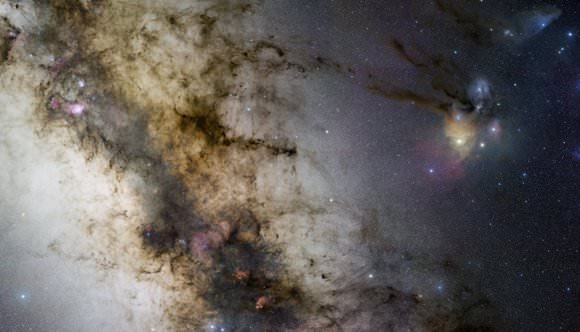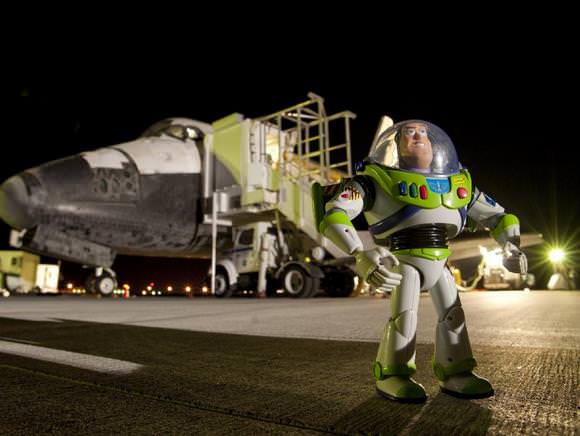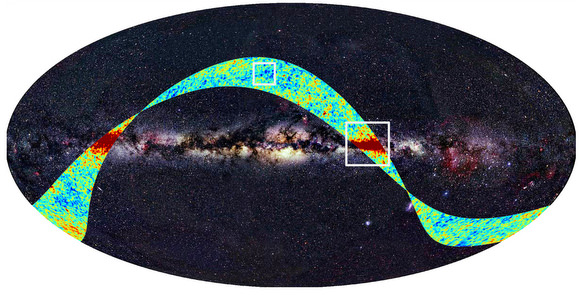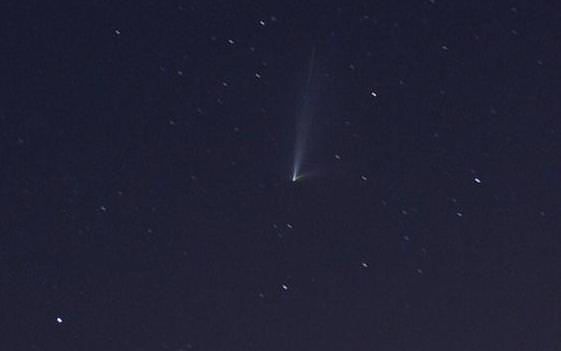NASA Science News for October 6, 2009
Archeologists are using NASA satellites and supercomputers to crack the mystery of the ancient Maya. New findings suggest the Maya may have played a key role in their own downfall.
FULL STORY at
http://science.nasa.gov/headlines/y2009/06oct_maya.htm?list1035898
NASA Science News for October 5, 2009
On Friday morning, Oct. 9th, you can watch a pair of spacecraft crash into the Moon with your own eyes. The purposeful impacts are the climax of NASA's LCROSS mission to unearth signs of water in lunar soil. Today's story tells how and where to look.
FULL STORY at
http://science.nasa.gov/headlines/y2009/05oct_lcrossvg.htm?list1035898
NASA Science News for September 29, 2009
NASA spacecraft are measuring record-high levels of cosmic rays--a side-effect of the deepest solar minimum in nearly a century. The cosmic ray storm appears to be intensifying, say researchers, and the peak may be yet to come.
FULL STORY at
http://science.nasa.gov/headlines/y2009/29sep_cosmicrays.htm?list1035898
NASA Science News for September 24, 2009
Fresh meteorite impacts are exposing underground ice on Mars. NASA's Mars Reconnaissance Orbiter is beaming back must-see photos of the process at work.
FULL STORY at
http://science.nasa.gov/headlines/y2009/24sep_martianice.htm?list1035898
NASA Science News for September 24, 2009
Using instruments on three separate spacecraft, scientists have discovered water molecules in the polar regions of the Moon.
FULL STORY at
http://science.nasa.gov/headlines/y2009/24sep_moonwater.htm?list1035898
NASA Science News for September 23, 2009
NASA's MESSENGER spacecraft is set to make its third and final flyby of the planet Mercury on Sept. 29th. The encounter is expected to produce hundreds of images of previously unseen terrain and confirm the strange elliptical shape of Mercury's equator.
FULL STORY at
http://science.nasa.gov/headlines/y2009/23sep_mercuryflyby3.htm?list1035898
340 Million Pixels of GigaGalaxy Zoom
Last week the GigaGalaxy Zoom project introduced an interactive 360-degree panorama of the entire night sky, and they promised more zoomable images to come. The second of three images is now available, and it is a wonderful 340-million-pixel vista of the central parts of our galactic home. Taken by Stéphane Guisard, an ESO engineer and world-renowned astrophotographer, the image shows the region spanning the sky from the constellation of Sagittarius (the Archer) to Scorpius (the Scorpion). This mosaic was assembled from 52 different sky fields made from about 1200 individual images totalling 200 hours exposure time, with the final image having a size of 24,403 x 13,973 pixels. Click on the image to get access to larger versions of the image. Jump right in and enjoy the views!
(...)
Read the rest of 340 Million Pixels of GigaGalaxy Zoom (165 words)
Why is Mars Red? New Study Offers Surprises
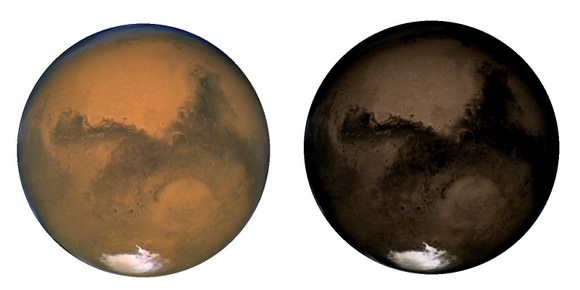
Is Mars red due to rocks being rusted by the water that once flooded the red planet? And is the only explanation for the hematite found by Mars orbiters and studied by the Mars Exploration rovers is that water once was present in volumes on Mars? Not necessarily, says a new study. Research done by Dr. Jonathan Merrison at the Aarhus Mars Simulation Laboratory in Denmark shows that the red dust that covers Mars may be formed by ongoing grinding of surface rocks. Liquid water need not have played any significant role in the red dust formation process.
(...)
Read the rest of Why is Mars Red? New Study Offers Surprises (533 words)
New Equinox Stunners From Cassini
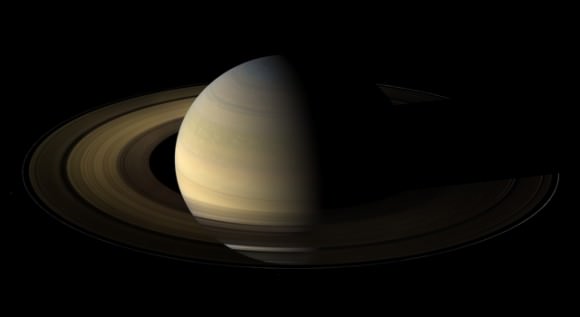
Every 14.8 Earth years, equinox occurs at Saturn. But this is the first time there has been a spacecraft in situ to watch what happens when the sun is directly overhead at the equator, illuminating the rings directly edge-on. New images compiled from the Cassini spacecraft show a rare and breathtaking display of nature: the setting of the sun on Saturn's rings. The image above — a mosaic of 75 different images — shows the beauty of this ringed world, but the most surprising revelation from these new images are that newly discovered lumps and bumps in the rings are as high as the Rocky Mountains.
(...)
Read the rest of New Equinox Stunners From Cassini (703 words)
NASA Science News for September 21, 2009
Using a colossal radio telescope in the Mojave Desert, school kids around the world are helping NASA track the LCROSS spacecraft as it heads for a crash landing on the Moon.
FULL STORY at
http://science.nasa.gov/headlines/y2009/21sep_gavrt.htm?list1035898
NASA Has a Little Fun With Buzz
Buzz Lightyear, that is. The action figure returned from space on Sept. 11, aboard space shuttle Discovery's STS-128 mission after 15 months aboard the International Space Station. Word has it that Disney is quite excited about his return, and will give him a ticker-tape parade on October 2, along with some of his his space station crewmates and the original Buzz, Apollo 11's Buzz Aldrin, at Walt Disney World in Florida.
So what was Buzz doing on the ISS?
(...)
Read the rest of NASA Has a Little Fun With Buzz (96 words)
Planck First Light
One of the newest telescopes in space, the Planck spacecraft, recently completed its "first light" survey which began on August 13. Astronomers say the initial data, gathered from Planck's vantage point at the L2 point in space, is excellent. Planck is studying the Cosmic Microwave Background, looking for variations in temperature that are about a million times smaller than one degree. This is comparable to measuring from Earth the body heat of a rabbit sitting on the Moon.
(...)
Read the rest of Planck First Light (221 words)
Weekend SkyWatcher's Forecast – September 18-20, 2009
 Greetings, fellow SkyWatchers! It's an awesome weekend forecast for many of us attending Fall Star Parties, and all over the world we're looking forward to moonless nights and the fellowship with our brother and sister amateur astronomers. If you've never been to a star party, try the Goggle pages for information… you just might find one going on near you! In the meantime, let's have us a "Snowball" fight, chase some galaxies and ponder double stars! I'll see you in the night…(...)
Greetings, fellow SkyWatchers! It's an awesome weekend forecast for many of us attending Fall Star Parties, and all over the world we're looking forward to moonless nights and the fellowship with our brother and sister amateur astronomers. If you've never been to a star party, try the Goggle pages for information… you just might find one going on near you! In the meantime, let's have us a "Snowball" fight, chase some galaxies and ponder double stars! I'll see you in the night…(...)
Read the rest of Weekend SkyWatcher's Forecast – September 18-20, 2009 (747 words)
Space Shuttle Flushes the Toilet for All the World To See
This picture is from last week; September 9, 2009 to be exact, but I still wanted to share it. I just got in touch with photographer Clair Perry from Prince Edward Island, Canada to get his permission to post the image. No, this is not a comet. Pictured is space shuttle Discovery executing a water dump. The shuttle needed to get rid of excess waste water before landing the next day, and jettisoned it overboard via the waste water dump line, creating a spectacular visual effect as sunlight hit the spraying water. This dump occurred just as the shuttle was flying over North America last week, and lots of people witnessed this "toilet flush." Some reports indicated it was "pristine" water (the shuttle fuel cells' by-product is water) and other reports said it was "waste water and urine" (the Bad Astronomer called it Constellation Urion). Whatever, it was pretty. NASA said this was an unusually large dump, about 150 pounds (68 kg), because new regulations say no shuttle water dumps can take place while docked to the ISS, so as not to contaminate the outdoor experiments on the Kibo lab.
See below for the spectacular entire image, which also includes the nearby ISS creating a streak in the sky. Thanks to Clair Perry for sharing his images.
(...)
Read the rest of Space Shuttle Flushes the Toilet for All the World To See (148 words)
Best Ever View of Andromeda in Ultraviolet
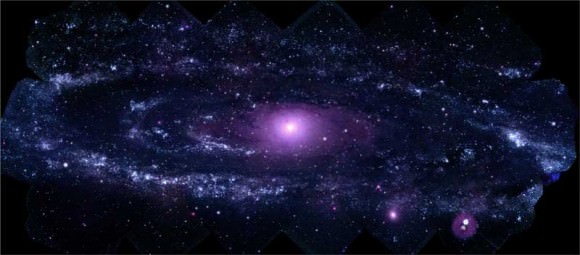
Normally, the Swift satellite is searching for distant cosmic explosions. But recently it took some time to take a long look (total exposure time: 24 hours) with its ultraviolet eyes at the Andromeda galaxy, a.k.a. M31. The result is this gorgeous image. "Swift reveals about 20,000 ultraviolet sources in M31, especially hot, young stars and dense star clusters," said Stefan Immler, a research scientist on the Swift team at NASA's Goddard Space Flight Center. "Of particular importance is that we have covered the galaxy in three ultraviolet filters. That will let us study M31's star-formation processes in much greater detail than previously possible."
Compare this image to an optical version taken by a ground-based telescope:
(...)
Read the rest of Best Ever View of Andromeda in Ultraviolet (157 words)
